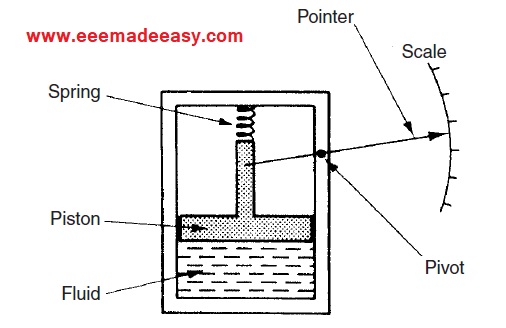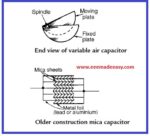Types of measuring instruments
Instrument types
Types of measuring instruments:Instruments can be subdivided into separate classes according to several criteria.
These subclassifications are useful in broadly establishing several attributes of particular instrumentssuch as accuracy, cost, and general applicability to different applications.
1. Active and passive instruments
2. Null-type and deflection-type instruments
3. Analogue and digital instruments
4. Indicating instruments and instruments with a signal output
5. Smart and non-smart instruments
Instruments are divided into active or passive ones according to whether the instrument output is entirely produced by the quantity being measured or whether the quantity being measured simply modulates the magnitude of some external power source.
1. Active and passive instruments
Example of a passive instrument :
A pressure-measuring device is shown in Figure below.
The pressure of the fluid is translated into a movement of a pointer against a scale.
The energy expended in moving the pointer is derived entirely from the change in pressure measured: there are no other energy inputs to the system.
Example of an active instrument
A float-type petrol tank level indicator as in Figure below.
Here, the change in petrol level moves a potentiometer arm, and the output signal consists of a proportion of the external voltage source applied across the two ends of the potentiometer.
The energy in the output signal comes from the external power source: the primary transducer float system is merely modulating the value of the voltage from this external power source.
In active instruments,the external power source is usually in electrical form, but in some cases, it can be other forms of energy such as a pneumatic or hydraulic one.
One very importantdifference between active and passive instruments is the level of measurement resolution that can be obtained.
2. Null-type and deflection-type instruments
The pressure gauge just mentioned is a good example of a deflection type of instrument, where the value of the quantity being measured is displayed in terms of the amount of movement of a pointer.
An alternative type of pressure gauge is the deadweight gauge shown in Figure below, which is a null-type instrument.
Here, weights are put on top of the piston until the downward force balances the fluid pressure.
Weights are added until the piston reaches a datum level, known as the null point. Pressure measurement is made in terms of the value of the weights needed to reach this null position.
3. Analogue and digital instruments
An analogue instrumentgives an output that varies continuously as the quantity being measured changes.
The output can have an infinite number of values within the range that the instrument is designed to measure.
The deflection-type of pressure gauge described earlier in this post is a good example of an analogue instrument.
As the input value changes, the pointer moves with a smooth continuous motion.
Whilst the pointer can therefore be in an infinite number of positions within its range of movement, the number of different positions that the eye can discriminate between is strictly limited, this discrimination being dependent upon how large the scale is and how finely it is divided.
A digital instrumenthas an output that varies in discrete steps and so can only have
a finite number of values.
The rev counter sketched in Figure is an example of a digital instrument.
 |
| rev counter |
A cam is attached to the revolving body whose motion is being measured, and on each revolution the cam opens and closes a switch.
The switching operations are counted by an electronic counter. This system can only count whole revolutions and cannot discriminate any motion that is less than a full revolution.
4. Indicating instruments and instruments with a signal output
The final way in which instruments can be divided is between those that merely give
an audio or visual indication of the magnitude of the physical quantity measured and
those that give an output in the form of a measurement signal whose magnitude is
proportional to the measured quantity.
The class of indicating instruments normally include all null-type instruments and
most passive ones. Indicators can also be further divided into those that have an analogue output and those that have a digital display.
A common analogue indicator is a liquid-in-glass thermometer. Another common indicating device, which exists in both analogue and digital forms, is the bathroom scale.
The older mechanical form of this is an analogue type of instrument that gives an output consisting of a rotating pointer moving against a scale (or sometimes a rotating scale moving against a pointer).
More recent electronic forms of bathroom scale have a digital output consisting of numbers presented on an electronic display.
One major drawback with indicating devices is that human intervention is required to read and record a measurement.
This process is particularly prone to error in the case of analogue output displays, although digital displays are not very prone to error unless the human reader is careless.
Instruments that have a signal-type output are commonly used as part of automatic control systems.
In other circumstances, they can also be found in measurement systems where the output measurement signal is recorded in some way for later use.
Usually, the measurement signal involved is an electrical voltage, but it can take other forms in some systems such as an electrical current, an optical signal or a pneumatic signal.
5. Smart and non-smart instruments
The advent of the microprocessor has created a new division in instruments between
those that do incorporate a microprocessor (smart) and those that don’t.
- Moving Iron Instruments|Types of Moving Iron Instruments|MI Instrument
- Electrical measuring instruments|Types of Measuring Instruments
- MCQ on Electrical Instruments
- [MCQ] Instrument Errors MCQ|Electrical Measurement Errors MCQ
- MCQ’s on Electrical Measuring Instruments|Instruments Objective Questions
- [PDF]Electrical Measurements Measuring Instruments Study Notes PDF|EMMI Notes EEE Made Easy
- Electronic Instruments MCQ|Objective Questions on Electronic Instruments
- Static characteristics of instruments
- Environment MCQ for RRB JE CBT 2|Objective Questions Environment for Competitive Exams
- RRB JE CBT 2 Computer Awareness Book Arihant|Objective Computer Awareness Book 2025
- RRB JE CBT 2 Exam Date 2025 Postponed|RRB JE CBT 2 Exam Date
- [PDF]RRB JE Result 03/2024 Cut off, Selected no of candidates for all regions
- [PDF]Final Answer Key Junior Instructor Mechanic Agricultural Machinery|643/2023 Solved Question paper
- Acoustics MCQs|Industries Extension officer|IEO 2025
- LASER MCQs| Industries Extension officer|IEO 2025
- Practical Types of Capacitors
- [PDF] Syllabus JUNIOR INSTRUCTOR MECHANIC AGRICULTURAL MACHINERY|643/2023 Syllabus Kerala PSC
- [PDF] Syllabus JUNIOR INSTRUCTOR WOOD WORK TECHNICIAN|674/2023 Syllabus Kerala PSC
- [PDF] Syllabus JUNIOR INSTRUCTOR MECHANIC CONSUMER ELECTRONIC APPLIANCES|670/2023 Syllabus Kerala PSC
- [PDF] Junior Instructor Hospital Housekeeping| 646/2023 syllabus Kerala PSC












